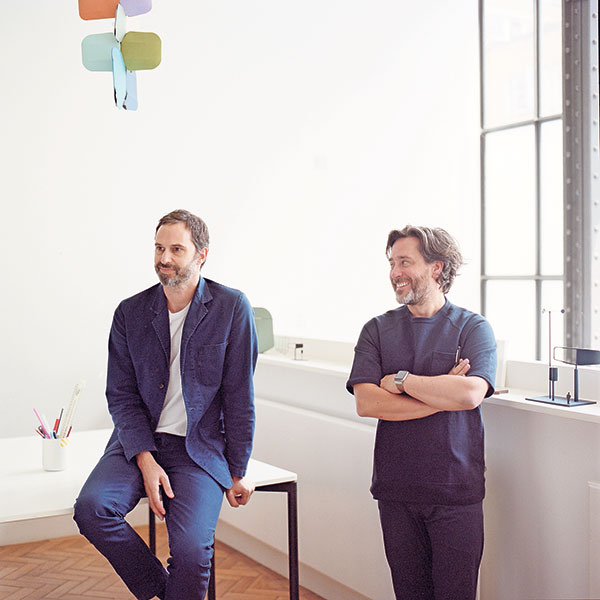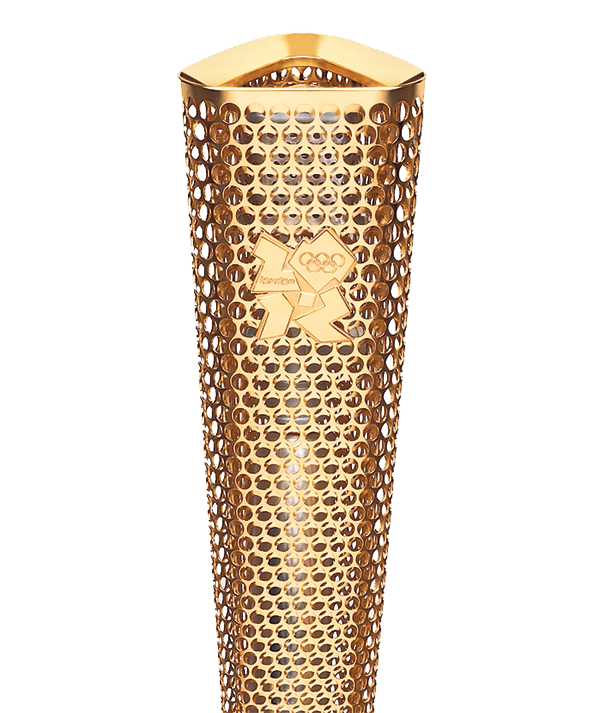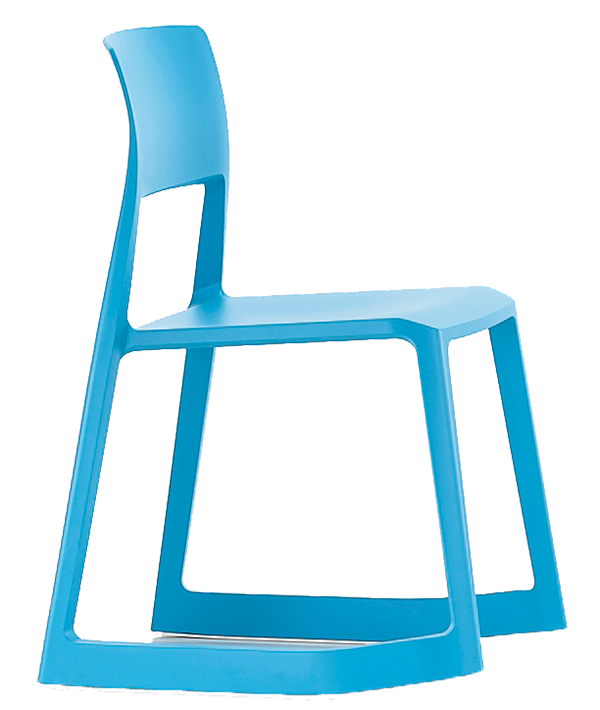Designers Barber and Osgerby on the first London Design Biennale

Simply sign up to the Life & Arts myFT Digest -- delivered directly to your inbox.
The front door of Barber and Osgerby, on Charlotte Road in east London’s Shoreditch, is black, unnamed and easy to walk past. Inside is a sprawling, partially subterranean office of white walls, metal beams and wooden floors. Employees in thick-framed glasses and monochrome clothes flit about. Over the past 13 years the space has been extended on to upper floors and under neighbouring buildings to accommodate the growing demands of one of the UK’s leading design studios.
Jay Osgerby and Edward Barber met while studying architecture at the Royal College of Art in 1992. They began by designing furniture and lighting for clients including Isokon, Capellini and Flos. Over the years, as the definition of “design” itself has diversified, their portfolio has broadened beyond high-end furniture to include a low-cost chair for schoolchildren, the foyer desk at the Royal Institute of British Architects, a £2 coin commemorating the 150th anniversary of the Underground and the London 2012 Olympic torch.
This month Barber and Osgerby will represent Britain at the inaugural London Design Biennale at Somerset House. Participants include 37 countries, from South Africa to Pakistan, as well as some of the world’s leading design museums, including Cooper Hewitt, the Smithsonian and the Victoria and Albert. Installations and a series of talks will explore the “big questions and ideas about sustainability, migration, pollution, energy, cities and social equality”, according to the event’s website.
For the field of design the biennale presents a watershed moment. “It’s taken a long time for design to mature as a profession and as a topic,” says Osgerby. “It’s been regarded as the commercialisation of creativity for a long time and this is one of the first times it’s being recognised as an art form, as architecture is.”
It is a very British summer day, sepia-toned with drizzle. Osgerby and Barber show me into a room with a large wooden table and seating for 12. “We couldn’t find a meeting room big enough,” Barber says drily. Both men are dressed inconspicuously. Barber, 47, wears a grey shirt and dark trousers; Osgerby, 46, is in a dark blazer and T-shirt. They both have beards flecked with white, worn to a similar degree of shagginess.
“I’ve got to warn you, I’m a bit brain-dead. I had a baby five days ago and I haven’t really slept since,” says Barber.
“And I’ve got dementia,” says Osgerby, smiling. “How long have you got?” The pair have the intimate habit of jumping in to play off or develop each other’s thoughts. “I would describe [our relationship] as a sort of fraternal thing without needing to worry about what we’re buying Mum or Dad for Christmas, without the family politics,” says Osgerby.
In 2001, because they were “turning away work” under their eponymous brand, Osgerby and Barber founded a sister architecture practice, Universal Design Studio, perhaps best known for designing the Ace Hotel in Shoreditch. In 2012 they launched MAP, a strategy-based industrial design studio with clients including Honda, Virgin Atlantic and Fortnum & Mason. (All housed on Charlotte Road.) It is what Osgerby calls the pair’s “creative promiscuity” that he thinks led to them being asked to represent the UK. “We are incredibly diverse as a studio, and it represents a lot of what creativity is here [in Britain]. It’s not segmented,” he says. Creative restlessness has always been a part of their dynamic. After the pair met at the Royal College — “we were pretty much sitting next to each other on the first day,” says Barber — they were united by a sense of dissatisfaction. “We were thinking, ‘hmmm, is this it? Not sure this is enough’. It wasn’t what we were expecting,” says Osgerby. Unfulfilled by the architecture course, they started doing projects on the side.

One evening they designed a table — “literally with a bit of cardboard and some scissors” — for a restaurant interior that never got made. The model sat on a shelf for a year in their first studio, in Trellick Tower, until a friend suggested they find a manufacturer. The Loop Table, formed of two pieces of curved plywood joined in an ellipse, was first produced by Isokon in 1997.
A year later it was picked up by the Italian furniture brand Capellini, and soon entered the permanent collections of London’s V&A and New York’s Museum of Modern Art. “Suddenly that was it, we were off,” says Barber. “We entered another world — one that we hadn’t necessarily planned to get into.”
What initially appealed to museum curators and design magazines was the simplicity of Barber and Osgerby’s work. The big furniture and interior designers of the time — Tom Dixon, Nigel Coates, Mark Brazier-Jones — were producing elaborate work. The Loop Table seemed to express something of a new generation, but it also straddled time; its elegance and functionality harked back to Bauhaus and the beginnings of Modernism. (One critic has described Barber and Osgerby as “Blairite” in their tendency to “take the inheritance of Modernism, rinse out its social aims and turn it to shaping blandly desirable consumables”.) Loop lacks Modernism’s asceticism, however. “It has a character that, well, I wouldn’t say is friendly, but it has something you can warm to,” says Barber.
The Tip Ton Chair (2011) is similarly expressive. The chair came to be after the Royal Society of Arts asked Barber and Osgerby to look at the furniture used in secondary schools. Concluding that what was on the market was no longer “relevant”, they set out to design a chair that was economical, robust enough for the classroom and yet conveyed a sense of play. Having learned that when the body is still for a long period it starts to shut down, closing the mind, they created a two-position plastic chair that allows the user to rock between a stable forward position (encouraging good posture) and a less rigid back position. “It’s a new archetype-ish,” says Osgerby.

“When you look at the chair now it seems very obvious but it didn’t before, and that I guess is a new archetype,” Barber elaborates.
While we have been talking, a scale model has been brought in and set up in a corner of the room. What looks like a cross between a desk tidy and a wind-up toy turns out to be a mock-up of Barber and Osgerby’s installation for the biennale, called Forecast. It is a response to the event’s theme of “utopia by design” in celebration of the 500th anniversary of the publication of Thomas More’s book Utopia.
The installation, placed in the courtyard of Somerset House, comprises three structures made of steel, aluminium and fibreglass with rotating parts. Somewhere between a wind turbine and a weather vane, the piece has more in common with kinetic sculpture than a design object in a functional sense. “It’s like a machine that doesn’t actually do anything. Utopia is an island that doesn’t exist — this is a utopian object,” says Barber. “I guess we’re trying to represent the country in a physical way. It’s all quite abstract.”
Forecast also feels political. It is a strange moment for London to host a design biennale. The city is regarded as the “international centre of design” for its proximity to established European manufacturers, for the quality of its arts education and for something less quantifiable, an “openness” to possibility and the exchange of cultural and creative ideas. “In London there are no preconceptions of what you should be doing or are not supposed to be doing,” says Barber. All of these elements have been magnetic, “drawing in the best creative minds to work here,” adds Osgerby.
How the UK’s vote to leave the EU will impact on this remains to be seen. As the nation reconfigures its relations with other countries and its role in the world, many in the creative industries in London — one of a few regions in England that voted to remain — have been grappling with the realisation that the UK is more deeply divided than previously thought.
“This idea of navigation and travel is really interesting at a time when we [the British] are perceived to be becoming isolationist,” says Osgerby. “Looking back at our history as an island nation, we relied on wind power to discover new places, to explore the world. In this object is this idea of the elements, which is a national preoccupation, and the discovery of new places, of seeking cultural enlightenment from travel.”
At a moment of social discord, heightened anxiety over immigration and economic unknowns, Forecast expresses something optimistic. Are designers utopians by default? “You have to be because you are always trying to improve things, always trying to find a better way to make it work,” says Barber. “That’s really our job.”
The London Design Biennale takes place at Somerset House from September 7 to 27
Main photograph: Gabby Laurent
Comments